Mini stent can be helpful in treatment of monocanalicular trauma
Surgeons describe the steps involved in canalicular repairs.
 Thomas John |
Traumatic lacerations of the eyelids require appropriate, timely surgical repair to re-establish the anatomic continuity of the involved lid margin. Any compromise to the normal anatomic position of the eyelid and altered lid function can adversely affect the tear film distribution on the ocular surface and have deleterious effects on the cornea and conjunctival surfaces of the globe. Additionally, lid margin scarring and positional alteration of the lid can result in mechanical damage to the corneal surface with secondary corneal erosions and possible secondary infection of the cornea. When such lid margin injury involves the canalicular system, there is the added risk of subsequent epiphora. Injury to the lacrimal system occurs in about 16% to 36% of patients with eyelid trauma. It is essential to re-establish the normal conduit of the lacrimal canalicular system in a timely fashion to prevent epiphora.
In this column, Drs. Small and Slonim describe their method of managing monocanalicular trauma using Mini Monoka stents (FCI Ophthalmics).
Thomas John, MD
OSN Surgical Maneuvers Editor
At our facility, we aim to repair all canalicular injuries within 24 to 36 hours of injury. The reason for this is twofold. First, the proximal and distal ends of the lacerated canaliculus can be easier to identify before fibrosis and edema distort the normal anatomy, and second, repair before significant scar formation leads to better outcomes.
Location of surgical repair
Our preference is to take the patient to an operating room and have the patient placed under general anesthesia. Because patients with this type of injury are commonly in pain from their injuries and may be uncooperative due to anxiety or inebriation, general anesthesia facilitates the repair by assuring a stable operating environment. We do, however, frequently repair canalicular injuries at the bedside under local anesthesia in our emergency department, where each patient room has surgical caliber spotlights and our oculoplastic surgical instrument tray can be brought into the room.
Canalicular repairs can be performed without the use of external magnification (eg, surgical loupes or operating microscope). Our preference is to use surgical loupes, which make the wound edges and canalicular lumens easier to identify.
The Mini Monoka
The Mini Monoka stent (Figure 1) is a silicone tube with a diameter of 0.64 mm and a punctal plug-like head. The construction of the stent head consists of a bulb attached to the silicone tube. A hollow body attaches the bulb to an oval collarette, which in turn holds the stent in place. This plug also maintains patency of the lacrimal system, as it has a lumen that is continuous with the lumen of the silicone tubing, thereby potentially reducing epiphora while the tubing is in place. It is ideal for most canalicular lacerations that involve the external two-thirds of the canaliculus, where the silicone tubing can be inserted directly into the distal end of the severed canaliculus and passed into the lacrimal sac or nasolacrimal duct.
Surgical technique
The surgical field is thoroughly cleansed with Betadine (povidone iodine, Purdue Pharma). Any foreign material is removed manually and with forceful irrigation using sterile saline in a 30- to 50-cc syringe through a 22-gauge Angiocath plastic tip. The punctum of the injured canaliculus is localized and dilated using stainless steel punctal dilators. A 00 Bowman probe is inserted vertically into the vertical canaliculus through the punctum to a depth of 2 mm. It is then turned nasally 90° to follow the path of the horizontal canaliculus. The site of the proximal side of the canalicular wound is isolated. Once identified, exploration begins for the distal end of the canalicular wound. Depending on the nature of the injury, the proximity of the laceration to the common canaliculus and the angle of the laceration, the distal end may be difficult to identify. A pigtail probe inserted into the uninjured canaliculus and rotated around the common canaliculus may help identify the distal end of the laceration (Figure 2).
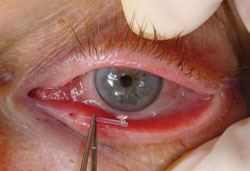 Figure 1. The Mini Monoka stent being inserted into the inferior canaliculus. |
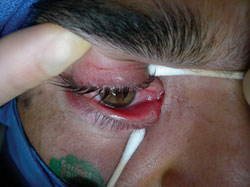 Figure 2. A pigtail probe was used to locate the lacerated edge of the superior canaliculus. Shown is the Mini Monoka inserted into the lower system and exiting the repaired upper system. Images: Slonim CB, Small
L |
Intubation
If the lesion is deemed appropriate for use of the Mini Monoka, the stent is inserted into the dilated punctum and advanced until it exits the canaliculus at the level of the laceration (Figure 3). We use non-toothed forceps with a hand-over-hand technique. The nasal portion of the lacerated canaliculus is located, and the stent is cautiously advanced into the lumen. The tube is then inserted fully until the head reaches the punctum. The lacerated ends of the canaliculus are approximated using two 7-0 chromic sutures passed through the exposed edges of the canaliculus. Before tying these sutures, the overlying subcutaneous tissues are approximated using 6-0 Vicryl sutures to decrease tension on the canalicular wound. Then, the two 7-0 chromic canalicular sutures are secured. Next, the overlying skin and lid margin, if applicable, are approximated using interrupted 6-0 Vicryl sutures in the tarsus and 6-0 chromic sutures in the skin edges (Figure 4). Any loose suture ends at the lid margin are secured under a more distal knot to prevent the ends from rubbing on the globe. An example of a completed repair is shown in Figure 5. If the wound edges are unable to be approximated or the tubing is unable to be easily fed into the distal canaliculus, a Mono-Crawford tube (FCI Ophthalmics) should be considered.
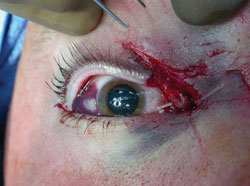 Figure 3. The Mini Monoka stent inserted into the punctum and exiting the lacerated portion of the canaliculus. |
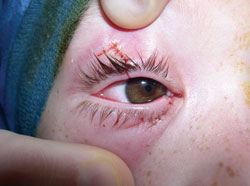 Figure 4. The upper and lower lids have been repaired as described using 6-0 Vicryl and 6-0 chromic sutures to approximate the tarsus and skin edges, respectively. |
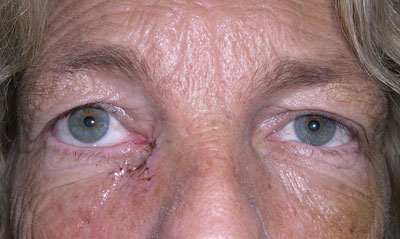 Figure 5. An example of a completed lower lid laceration repair. |
An antibiotic ointment is applied to the sutures at the end of the procedure and is used twice a day for 1 week to prevent infection. Patient follow-up is at 1 week to check for infection and stable stent position in the punctum. The Mini Monoka stent is removed at 2 to 3 months (4 to 6 months if difficult intubation or complicated injury required Mono-Crawford use) in the office using forceps. The patient can then be seen on an as-needed basis. The lacrimal system is not tested for patency unless the patient has symptoms of epiphora so as not to accidentally disrupt the recently anastomosed ends.
References:
- Anastas CN, Potts MJ, Raiter J. Mini Monoka silicone monocanalicular lacrimal stents: Subjective and objective outcomes. Orbit. 2001;20(3):189-200.
- Drnovsek-Olup B, Beltram M. Trauma of the lacrimal drainage system: retrospective study of 32 patients. Croat Med J. 2004;45(3):292-294.
- Eo S, Park J, Cho S, Azari KK. Microsurgical reconstruction for canalicular laceration using Monostent and Mini-Monoka. Ann Plast Surg. 2010;64(4):421-427.
- Reifler DM. Management of canalicular laceration. Surv Ophthalmol. 1991;36(2):113-132.
- Saunders DH, Shannon GM, Flanagan JC. The effectiveness of the pigtail probe method of repairing canalicular lacerations. Ophthalmic Surg. 1978;9(3):33-40.
- Thomas John, MD, is a clinical associate professor at Loyola University at Chicago and is in private practice in Oak Brook, Tinley Park and Oak Lawn, Ill. He can be reached at 708-429-2223; fax: 708-429-2226; e-mail: tjcornea@gmail.com.
- Charles B. Slonim, MD, FACS, can be reached at USF Eye Institute, 13127 Magnolia Drive, Tampa FL 33612; 813-974-2064; fax: 813-974-5621; e-mail: cslonim@health.usf.edu.
- Laurie Small, MD, can be reached at lsmall2@health.usf.edu.
- Disclosures: Drs. John, Slonim and Small have no relevant financial disclosures.

